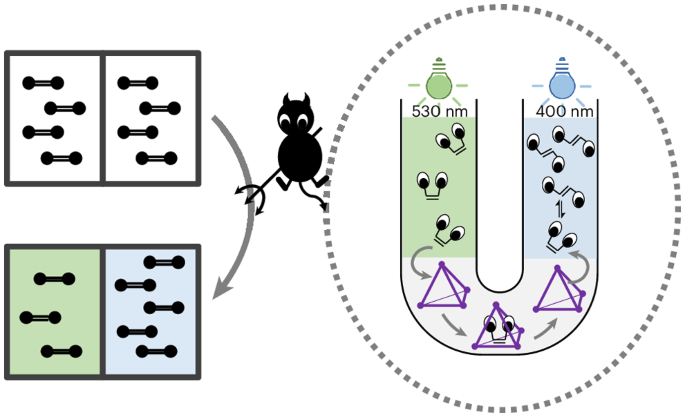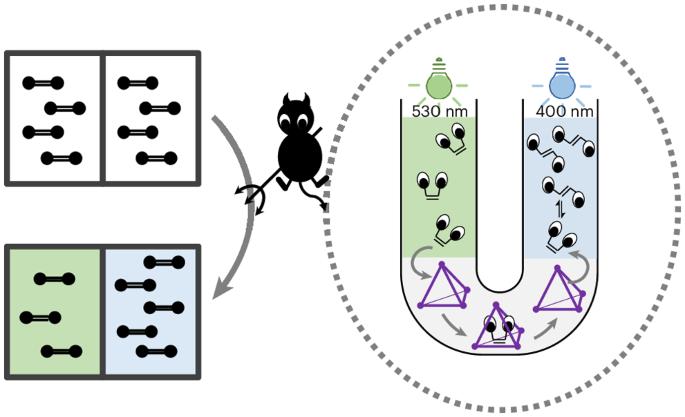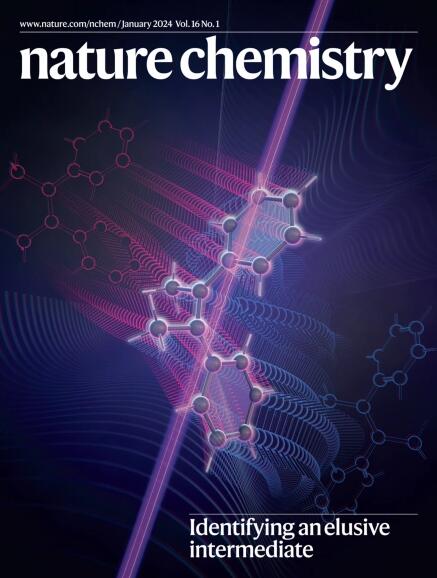利用麦克斯韦定律建立宏观浓度梯度
IF 19.2
1区 化学
Q1 CHEMISTRY, MULTIDISCIPLINARY
引用次数: 0
摘要
麦克斯韦的恶魔 "描述了一个思想实验,在这个实验中,一个 "恶魔 "调节两个相邻空间之间的粒子流,建立了一个电势梯度,但似乎并没有做功。这个看似矛盾的现象让人们认识到,排序需要热力学功,这是信息论的一个基础概念。在过去的几个世纪中,人们以分子信息、分子泵和棘轮的形式提出了许多与麦克斯韦妖类似的系统。在这里,我们报告了一个麦克斯韦恶魔的功能实例,它能将材料泵送到几厘米的范围内,而之前的实例是在分子尺度上运行的。在我们的系统中,当光线照射时,麦克斯韦妖驱动邻氟偶氮苯在 U 形管装置的两臂之间定向传输,并通过含有配位笼的水膜。由此获得的浓度梯度被进一步用于驱动萘的反向传输。本文章由计算机程序翻译,如有差异,请以英文原文为准。


Harnessing Maxwell’s demon to establish a macroscale concentration gradient
Maxwell’s demon describes a thought experiment in which a ‘demon’ regulates the flow of particles between two adjoining spaces, establishing a potential gradient without appearing to do work. This seeming paradox led to the understanding that sorting entails thermodynamic work, a foundational concept of information theory. In the past centuries, many systems analogous to Maxwell’s demon have been introduced in the form of molecular information, molecular pumps and ratchets. Here we report a functional example of a Maxwell’s demon that pumps material over centimetres, whereas previous examples operated on a molecular scale. In our system, this demon drives directional transport of o-fluoroazobenzene between the arms of a U-tube apparatus upon light irradiation, transiting through an aqueous membrane containing a coordination cage. The concentration gradient thus obtained is further harnessed to drive naphthalene transport in the opposite direction. In the original Maxwell’s demon thought experiment, a potential gradient of particles between two neighbouring compartments is created without the apparent use of work. Now a functional example of this experiment where material is pumped over centimetres has been reported—o-fluoroazobenzene is transported unidirectionally under light stimulation between two arms of a U-tube across an aqueous layer containing coordination cages.
求助全文
通过发布文献求助,成功后即可免费获取论文全文。
去求助
来源期刊

Nature chemistry
化学-化学综合
CiteScore
29.60
自引率
1.40%
发文量
226
审稿时长
1.7 months
期刊介绍:
Nature Chemistry is a monthly journal that publishes groundbreaking and significant research in all areas of chemistry. It covers traditional subjects such as analytical, inorganic, organic, and physical chemistry, as well as a wide range of other topics including catalysis, computational and theoretical chemistry, and environmental chemistry.
The journal also features interdisciplinary research at the interface of chemistry with biology, materials science, nanotechnology, and physics. Manuscripts detailing such multidisciplinary work are encouraged, as long as the central theme pertains to chemistry.
Aside from primary research, Nature Chemistry publishes review articles, news and views, research highlights from other journals, commentaries, book reviews, correspondence, and analysis of the broader chemical landscape. It also addresses crucial issues related to education, funding, policy, intellectual property, and the societal impact of chemistry.
Nature Chemistry is dedicated to ensuring the highest standards of original research through a fair and rigorous review process. It offers authors maximum visibility for their papers, access to a broad readership, exceptional copy editing and production standards, rapid publication, and independence from academic societies and other vested interests.
Overall, Nature Chemistry aims to be the authoritative voice of the global chemical community.
 求助内容:
求助内容: 应助结果提醒方式:
应助结果提醒方式:


